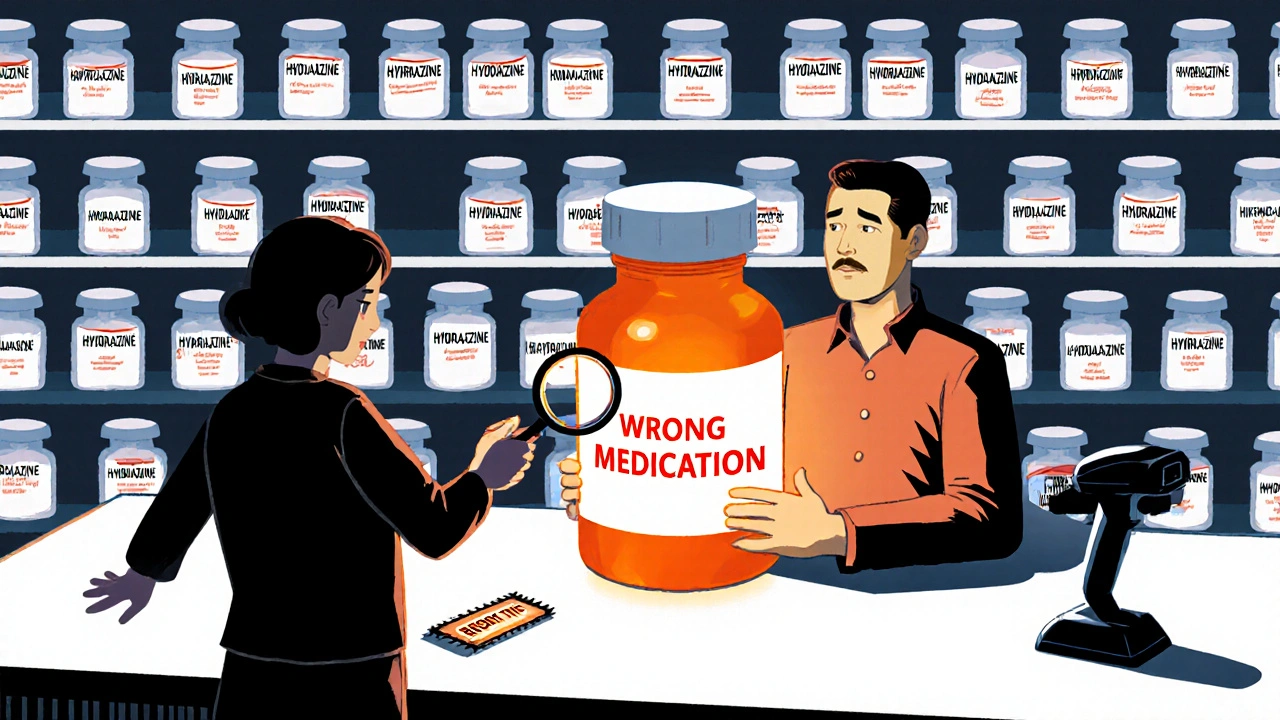If you open your prescription bottle and the pills look nothing like what you expected, stop. Don’t take another one. Don’t toss it. Don’t pretend it’s fine. A pharmacy error isn’t just a mix-up-it’s a potential emergency. You might be holding a medication meant for someone else, a drug with dangerous side effects, or a completely wrong dose. These mistakes happen more often than you think. In the U.S. alone, over 1.5 million people are affected by medication errors every year. And while many are minor, others lead to hospital visits, long-term harm, or worse.
Stop Taking the Medication Immediately
The first thing you do after realizing something’s wrong? Stop. Right now. Even if you feel fine. The effects of the wrong medication might not show up for hours-or days. Some drugs, like blood thinners or insulin, can cause serious harm even in small doses. Others, like ADHD medications or antidepressants, can trigger anxiety, rapid heartbeat, or confusion in people who aren’t prescribed them. Don’t wait for symptoms. Don’t assume it’s a harmless mix-up. Your body doesn’t know the difference between what’s supposed to be there and what isn’t. If you’ve already taken one or two pills, write down exactly when and how many. That information will matter later.Call Your Doctor Right Away
Your doctor needs to know this happened. Not tomorrow. Not after lunch. Now. They’re the only one who can tell you whether the medication you received is dangerous for you specifically. Maybe it’s a drug you’re allergic to. Maybe it interacts with your other medications. Maybe it’s a high-risk drug like warfarin or lithium. Your doctor might tell you to come in for blood tests, adjust your treatment plan, or even send you straight to the ER. Don’t delay. If you’re dizzy, nauseous, having chest pain, or trouble breathing, call 911 or go to the nearest emergency room. Don’t wait to hear back from your doctor. Trust your body. If something feels wrong, it probably is.Contact the Pharmacy-But Don’t Just Talk, Document
Call the pharmacy where you picked up the medication. Ask to speak with the head pharmacist or manager. Don’t settle for a front desk clerk. They need to know this isn’t just a complaint-it’s a safety incident. Say clearly: “I received the wrong medication. I need to speak with the person in charge.” Write down the date, time, and name of the person you spoke with. Ask them to confirm in writing what happened. Many pharmacies will send you an email or letter acknowledging the error. Keep that. If they refuse to document it, write your own note: “Called [Pharmacy Name] on [date] at [time]. Spoke with [name]. Confirmed wrong medication was dispensed: [name of drug].” Sign and date it. This isn’t about blame-it’s about proof. And proof matters if things get worse.
Keep Everything-Don’t Throw Anything Away
Save the wrong medication. Keep the bottle. Hold onto the receipt. Keep the original prescription label if you still have it. Even the plastic bag the pharmacy gave you. These are evidence. If you need to file a report, make a claim, or take legal action, this is what you’ll need. Take clear photos of the pills inside the bottle. Compare them to the label. Take a picture of the prescription slip your doctor wrote. If you have the correct medication from a previous fill, take a photo of that too. Video works even better-record yourself opening the bottle, reading the label, showing the pills. A 30-second clip can be worth thousands in a settlement. Don’t give the wrong medication back to the pharmacy. They might destroy it. You need it.Report It-To the Right Places
You’re not just protecting yourself. You’re protecting the next person who walks into that pharmacy. Report the error to the Institute for Safe Medication Practices (ISMP). They run a confidential system that collects over 100,000 medication error reports. You don’t need to give your name. You just need to describe what happened. The more reports they get, the more pressure pharmacies face to fix their systems. Also report it to your state’s pharmacy board. In Australia, that’s the Australian Health Practitioner Regulation Agency (AHPRA). In the U.S., it’s your state’s Board of Pharmacy. These agencies investigate serious errors. They can suspend licenses, require retraining, or force pharmacies to install barcode scanning systems. According to the FDA, over 92,000 medication errors were reported in 2022-but experts say less than 15% are ever reported. Don’t be silent. Your report could prevent a death.Understand the Legal Side-Before You Do Anything
Pharmacy errors can be medical malpractice. If the mistake caused you harm-physical, emotional, or financial-you may have a case. The average settlement for these cases ranges from $50,000 to $500,000. In extreme cases-like a child taking the wrong medication and ending up in the ICU-settlements have exceeded $10 million. But here’s the catch: you have to act fast. Most states and countries have a time limit-usually one to three years-from when you discovered the error. In some places, it’s as short as six months if it involves a government hospital. Don’t wait. Don’t sign anything the pharmacy gives you. Don’t give a recorded statement. Don’t accept a gift card or refund as “compensation.” That’s often a tactic to stop you from pursuing legal action later. If you’re considering legal steps, talk to a lawyer who specializes in medical errors. They’ll help you gather the right documents: your medical records, pharmacy records, proof of purchase, and your photos or videos. Over 90% of successful claims include visual evidence of the wrong medication. Video increases settlement value by nearly 40%.
Why This Happens-and How to Prevent It Next Time
These mistakes aren’t random. They’re systemic. Pharmacists are overworked. Prescriptions are handwritten or scanned poorly. Similar drug names-like Hydralazine and Hydroxyzine-get mixed up. High-alert medications like insulin, opioids, and blood thinners are especially risky. The best pharmacies use barcode scanning. It cuts dispensing errors by 85%. But only about 60% of U.S. pharmacies use it. In Australia, adoption is growing but still uneven. You can ask: “Do you scan prescriptions before filling?” If they say no, consider switching. Here’s how to protect yourself every time:- Check the label before you leave the counter. Does the name match your prescription? Does the dosage match what your doctor told you?
- Compare the pills to your last fill. If the color, shape, or imprint is different, ask why.
- Ask the pharmacist: “Is this what my doctor ordered?” Don’t be shy. They’re trained to explain this.
- Use one pharmacy for all your prescriptions. That way, they can catch dangerous interactions.
- Keep a list of all your medications-including doses and why you take them. Bring it to every appointment.
What Happens If You Don’t Act
Ignoring a wrong medication isn’t just risky-it’s dangerous. People who’ve taken the wrong drug often feel fine at first. Then, days later, they get sick. Or their condition worsens. Or they have a reaction they never expected. Studies show patients who experience medication errors have a 28% higher chance of dying within five years. For those who took the wrong heart or blood pressure medication, that risk jumps to 42%. These aren’t rare cases. They’re documented in the Journal of the American Medical Association. The cost to the healthcare system? Over $8 billion a year in the U.S. alone. This isn’t about punishing a pharmacist. It’s about forcing systems to change. Every time you report an error, you push for better training, better technology, better safety checks. Every time you speak up, you save someone else’s life.Final Checklist: What to Do Right Now
- Stop taking the medication.
- Call your doctor-immediately.
- Call the pharmacy and ask for the manager.
- Take photos and videos of the pills, bottle, and label.
- Save the receipt, bottle, and any paperwork.
- Write down when you noticed the error and what you felt (if anything).
- Report it to your country’s medication safety agency.
- Do not sign anything or accept a settlement without legal advice.
You didn’t do anything wrong. This isn’t your fault. But how you respond now could save your life-or someone else’s.
What should I do if I already took the wrong medication?
Stop taking it immediately. Call your doctor or go to the nearest emergency room if you feel unwell-symptoms like dizziness, chest pain, confusion, or rapid heartbeat need urgent attention. Even if you feel fine, tell your doctor what you took and when. They may order tests to check for side effects. Don’t wait for symptoms to get worse.
Can I get compensation if I received the wrong medication?
Yes, if the error caused you harm-physical, emotional, or financial-you may be eligible for compensation. This includes medical bills, lost wages, or pain and suffering. Settlements range from $50,000 to over $500,000 depending on severity. You’ll need documentation: photos of the medication, pharmacy records, medical reports, and proof of expenses. Talk to a lawyer before accepting any offer from the pharmacy.
How common are pharmacy errors?
They’re more common than most people think. In the U.S., about 1.5 million medication errors happen each year, with 26% occurring during dispensing at pharmacies. In Australia, reports are lower but rising. Experts estimate less than 15% of all errors are ever reported, meaning the real number could be much higher.
Should I report the pharmacy even if I didn’t get hurt?
Absolutely. Even if you didn’t suffer harm, reporting the error helps prevent future mistakes. Regulatory agencies use these reports to identify patterns, enforce safety rules, and require pharmacies to improve. Your report could stop someone else from being hospitalized-or worse.
What if the pharmacy says it was my mistake?
Pharmacies sometimes try to shift blame. But if the label on the bottle doesn’t match your doctor’s prescription, it’s their error-not yours. Keep your records: the original prescription, your photos, and any communication with the pharmacy. If they refuse to admit fault, report them to your national health regulator. You have the right to safe medication.
How can I avoid this in the future?
Always check your medication before leaving the pharmacy. Compare the pills to your last fill. Ask the pharmacist: “Is this what my doctor ordered?” Use one pharmacy for all your prescriptions so they can track interactions. Ask if they use barcode scanning. And keep a written list of all your medications, including dosages and reasons for taking them.



Emily Entwistle
17 November / 2025OMG this is so important!! 🙌 I once got a bottle of blood pressure meds instead of my anxiety pills-felt like I was gonna die at 2am. Called my doc, took pics, saved everything. They apologized and gave me a $50 gift card. LMAO like that fixes trauma. But seriously, DO NOT IGNORE THIS. Your life isn’t a gamble.